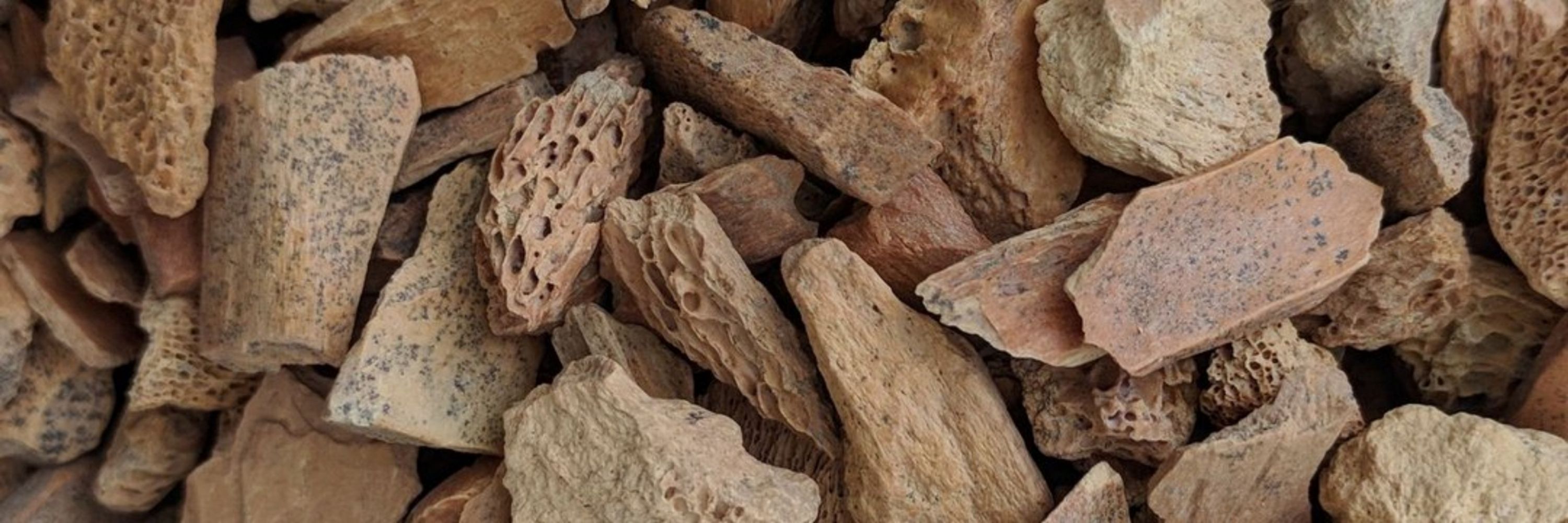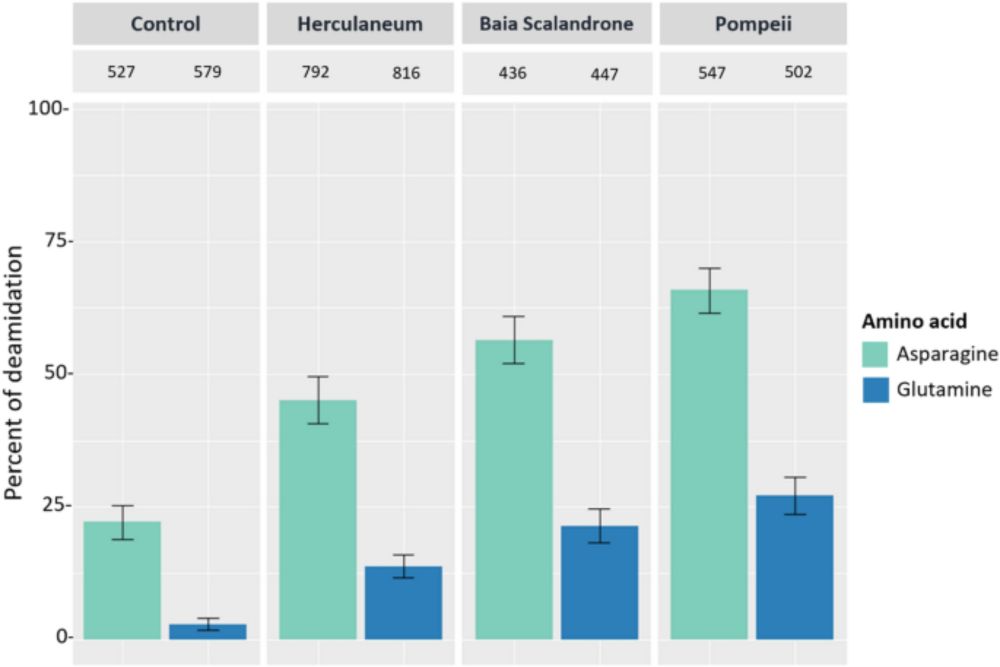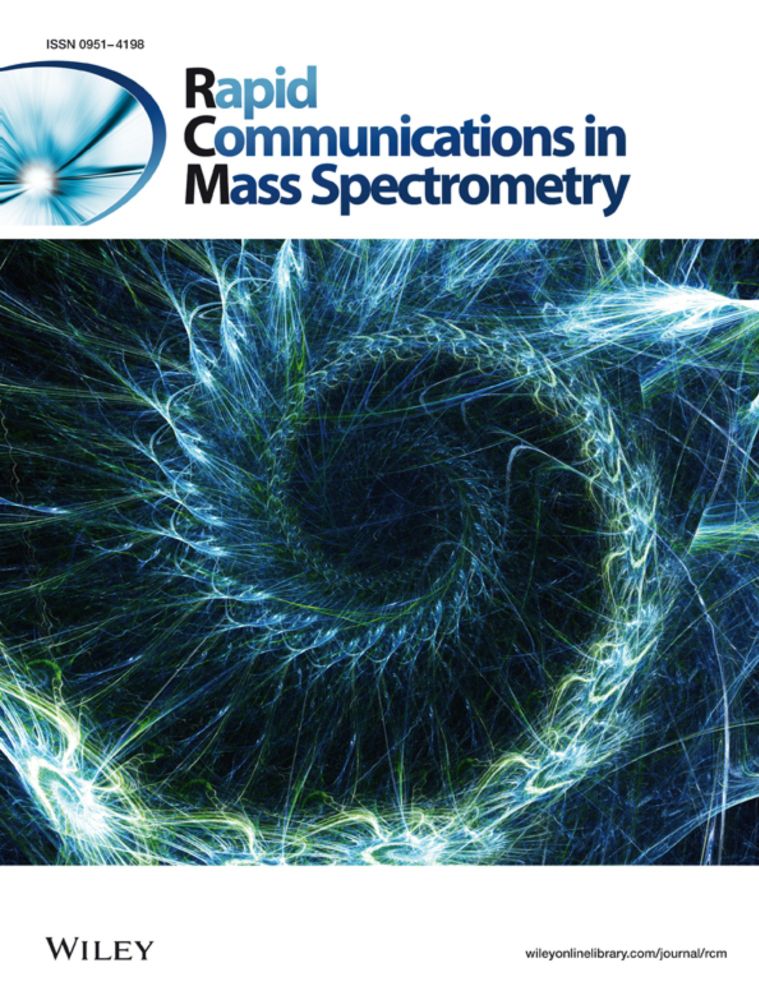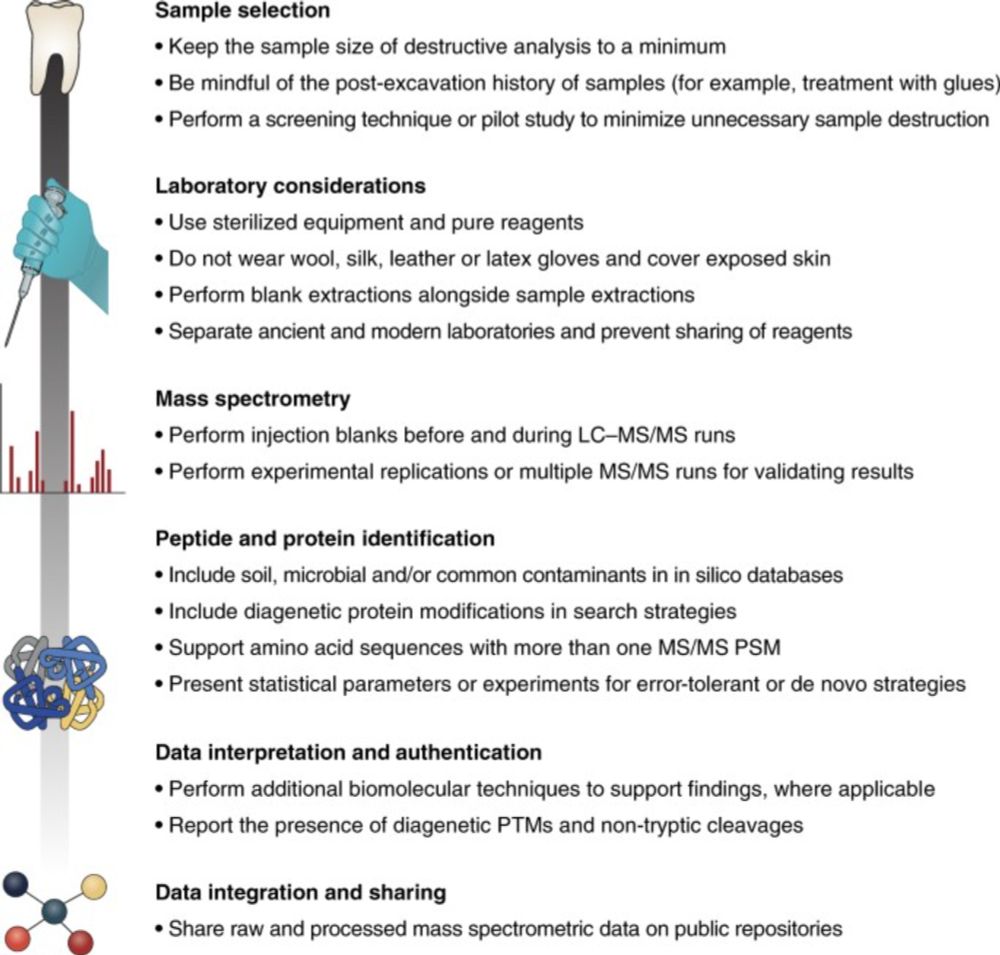
Sam Brown
@drsambrown.bsky.social
Palaeoproteomics Researcher at CENIEH
🧪👩🔬🦴🦷🌏
Building a brand new #palaeoproteomics laboratory here in Burgos, Spain. Exciting new things on the horizon!
#archaeology #evolution #palaeolithic #ZooMS #proteins
🧪👩🔬🦴🦷🌏
Building a brand new #palaeoproteomics laboratory here in Burgos, Spain. Exciting new things on the horizon!
#archaeology #evolution #palaeolithic #ZooMS #proteins
🥹 that's beautiful
February 14, 2025 at 1:52 PM
🥹 that's beautiful
I'm so glad you think so! Thanks!
February 14, 2025 at 8:31 AM
I'm so glad you think so! Thanks!
Oh thank goodness, I was worried about the resin community
February 12, 2025 at 2:41 PM
Oh thank goodness, I was worried about the resin community
Week 11 – Pottery and Residues
This week is all about how ancient people did not wash their pottery very well and how grateful we should all be about that. Take a look at these studies from Çatalhöyük, Turkey (dx.doi.org/10.1038/s414...) and Baħrija, Malta (dx.doi.org/10.1007/s007...)
This week is all about how ancient people did not wash their pottery very well and how grateful we should all be about that. Take a look at these studies from Çatalhöyük, Turkey (dx.doi.org/10.1038/s414...) and Baħrija, Malta (dx.doi.org/10.1007/s007...)

Ancient proteins from ceramic vessels at Çatalhöyük West reveal the hidden cuisine of early farmers - Nature Communications
Ancient diets have been reconstructed from archaeological pottery based on lipid remains, but these can lack specificity. Here, Hendy and colleagues analyze ancient proteins from ceramic vessels up to...
dx.doi.org
February 12, 2025 at 11:16 AM
Week 11 – Pottery and Residues
This week is all about how ancient people did not wash their pottery very well and how grateful we should all be about that. Take a look at these studies from Çatalhöyük, Turkey (dx.doi.org/10.1038/s414...) and Baħrija, Malta (dx.doi.org/10.1007/s007...)
This week is all about how ancient people did not wash their pottery very well and how grateful we should all be about that. Take a look at these studies from Çatalhöyük, Turkey (dx.doi.org/10.1038/s414...) and Baħrija, Malta (dx.doi.org/10.1007/s007...)
Week 10 – Ancient Textiles
The precious nature of textiles makes them such a unique view point into the archaeological world. Here are two papers on how ancient proteins can help us understand Pre-Columbian textiles (dx.doi.org/10.1016/j.ja...) and Viking clothing (dx.doi.org/10.1016/j.jp...)
The precious nature of textiles makes them such a unique view point into the archaeological world. Here are two papers on how ancient proteins can help us understand Pre-Columbian textiles (dx.doi.org/10.1016/j.ja...) and Viking clothing (dx.doi.org/10.1016/j.jp...)
Redirecting
dx.doi.org
February 12, 2025 at 11:16 AM
Week 10 – Ancient Textiles
The precious nature of textiles makes them such a unique view point into the archaeological world. Here are two papers on how ancient proteins can help us understand Pre-Columbian textiles (dx.doi.org/10.1016/j.ja...) and Viking clothing (dx.doi.org/10.1016/j.jp...)
The precious nature of textiles makes them such a unique view point into the archaeological world. Here are two papers on how ancient proteins can help us understand Pre-Columbian textiles (dx.doi.org/10.1016/j.ja...) and Viking clothing (dx.doi.org/10.1016/j.jp...)
Week 9 – Dental Calculus
If you don’t finish this week’s readings with a powerful urge to brush your teeth, then I am not doing my job. Welcome to the wonderful world of dental calculus, from the Neolithic link.springer.com/article/10.1... to the Bronze Age www.nature.com/articles/s41...
If you don’t finish this week’s readings with a powerful urge to brush your teeth, then I am not doing my job. Welcome to the wonderful world of dental calculus, from the Neolithic link.springer.com/article/10.1... to the Bronze Age www.nature.com/articles/s41...

New insights into Neolithic milk consumption through proteomic analysis of dental calculus - Archaeological and Anthropological Sciences
There has long been debate over the origins of dairy consumption within European populations. Whilst it was previously assumed that lactase persistence (LP) was under positive selection following the ...
link.springer.com
February 12, 2025 at 11:16 AM
Week 9 – Dental Calculus
If you don’t finish this week’s readings with a powerful urge to brush your teeth, then I am not doing my job. Welcome to the wonderful world of dental calculus, from the Neolithic link.springer.com/article/10.1... to the Bronze Age www.nature.com/articles/s41...
If you don’t finish this week’s readings with a powerful urge to brush your teeth, then I am not doing my job. Welcome to the wonderful world of dental calculus, from the Neolithic link.springer.com/article/10.1... to the Bronze Age www.nature.com/articles/s41...
Week 8 – Enamel
Enamel might be the hardest tissue in the body but it will hold a tender place in your heart… too much? Check out enamel proteins for sex estimation (dx.doi.org/10.1002/ajpa...) And this (very advanced - sorry 😅) paper on a Rhino tooth from Dmanisi (dx.doi.org/10.1038/s415...)
Enamel might be the hardest tissue in the body but it will hold a tender place in your heart… too much? Check out enamel proteins for sex estimation (dx.doi.org/10.1002/ajpa...) And this (very advanced - sorry 😅) paper on a Rhino tooth from Dmanisi (dx.doi.org/10.1038/s415...)

Sex estimation of teeth at different developmental stages using dimorphic enamel peptide analysis
Mandible and developing teeth of a perinatal infant.
dx.doi.org
February 12, 2025 at 11:16 AM
Week 8 – Enamel
Enamel might be the hardest tissue in the body but it will hold a tender place in your heart… too much? Check out enamel proteins for sex estimation (dx.doi.org/10.1002/ajpa...) And this (very advanced - sorry 😅) paper on a Rhino tooth from Dmanisi (dx.doi.org/10.1038/s415...)
Enamel might be the hardest tissue in the body but it will hold a tender place in your heart… too much? Check out enamel proteins for sex estimation (dx.doi.org/10.1002/ajpa...) And this (very advanced - sorry 😅) paper on a Rhino tooth from Dmanisi (dx.doi.org/10.1038/s415...)
Week 7 – Eggshell
Welcome to the fascinating world of eggs! #Darwin would have loved this one. Look how far back in time we can recover eggshell proteins in this paper (dx.doi.org/10.7554/eLif...) and PMF approaches to their study in this paper (dx.doi.org/10.1080/2054...)
Welcome to the fascinating world of eggs! #Darwin would have loved this one. Look how far back in time we can recover eggshell proteins in this paper (dx.doi.org/10.7554/eLif...) and PMF approaches to their study in this paper (dx.doi.org/10.1080/2054...)

Protein sequences bound to mineral surfaces persist into deep time
A chemically unstable ostrich eggshell peptide survives for at least 3.8 million years at the equator, stabilized by strong mineral interactions.
dx.doi.org
February 12, 2025 at 11:16 AM
Week 7 – Eggshell
Welcome to the fascinating world of eggs! #Darwin would have loved this one. Look how far back in time we can recover eggshell proteins in this paper (dx.doi.org/10.7554/eLif...) and PMF approaches to their study in this paper (dx.doi.org/10.1080/2054...)
Welcome to the fascinating world of eggs! #Darwin would have loved this one. Look how far back in time we can recover eggshell proteins in this paper (dx.doi.org/10.7554/eLif...) and PMF approaches to their study in this paper (dx.doi.org/10.1080/2054...)
Week 6 – Archaeological bone
You need to read this absolute STUDENT FAVOURITE paper on Iroquoian bone points (dx.doi.org/10.1038/s415...) and (OK this is not really an intro paper) but this multi-protease study highlights so many possibilities in studying bones (dx.doi.org/10.1016/j.jp...).
You need to read this absolute STUDENT FAVOURITE paper on Iroquoian bone points (dx.doi.org/10.1038/s415...) and (OK this is not really an intro paper) but this multi-protease study highlights so many possibilities in studying bones (dx.doi.org/10.1016/j.jp...).

Identifying Archaeological Bone via Non-Destructive ZooMS and the Materiality of Symbolic Expression: Examples from Iroquoian Bone Points - Scientific Reports
Scientific Reports - Identifying Archaeological Bone via Non-Destructive ZooMS and the Materiality of Symbolic Expression: Examples from Iroquoian Bone Points
dx.doi.org
February 12, 2025 at 11:16 AM
Week 6 – Archaeological bone
You need to read this absolute STUDENT FAVOURITE paper on Iroquoian bone points (dx.doi.org/10.1038/s415...) and (OK this is not really an intro paper) but this multi-protease study highlights so many possibilities in studying bones (dx.doi.org/10.1016/j.jp...).
You need to read this absolute STUDENT FAVOURITE paper on Iroquoian bone points (dx.doi.org/10.1038/s415...) and (OK this is not really an intro paper) but this multi-protease study highlights so many possibilities in studying bones (dx.doi.org/10.1016/j.jp...).
Weeks 4 and 5 – Post Translational Modifications
Let me convince you that the way proteins degrade in the archaeological record is actually the most FASCINATING thing on the planet with these papers on Herculaneum and Pompei (dx.doi.org/10.1038/s415...) and Milk! (dx.doi.org/10.1038/s415...)
Let me convince you that the way proteins degrade in the archaeological record is actually the most FASCINATING thing on the planet with these papers on Herculaneum and Pompei (dx.doi.org/10.1038/s415...) and Milk! (dx.doi.org/10.1038/s415...)

Molecular signatures written in bone proteins of 79 AD victims from Herculaneum and Pompeii - Scientific Reports
Scientific Reports - Molecular signatures written in bone proteins of 79 AD victims from Herculaneum and Pompeii
dx.doi.org
February 12, 2025 at 11:16 AM
Weeks 4 and 5 – Post Translational Modifications
Let me convince you that the way proteins degrade in the archaeological record is actually the most FASCINATING thing on the planet with these papers on Herculaneum and Pompei (dx.doi.org/10.1038/s415...) and Milk! (dx.doi.org/10.1038/s415...)
Let me convince you that the way proteins degrade in the archaeological record is actually the most FASCINATING thing on the planet with these papers on Herculaneum and Pompei (dx.doi.org/10.1038/s415...) and Milk! (dx.doi.org/10.1038/s415...)
Week 3 – Shotgun Proteomics!
Since it’s Darwin Day take a look at the evolutionary history of his fav ungulates (dx.doi.org/10.1038/natu...) and this paper on birds (dx.doi.org/10.1093/zool...) to dip your toes into shotgun proteomics on ancient specimens
Since it’s Darwin Day take a look at the evolutionary history of his fav ungulates (dx.doi.org/10.1038/natu...) and this paper on birds (dx.doi.org/10.1093/zool...) to dip your toes into shotgun proteomics on ancient specimens

Ancient proteins resolve the evolutionary history of Darwin’s South American ungulates - Nature
Protein sequences preserved in two Quaternary taxa, Macrauchenia and Toxodon, resolve the evolutionary history of South American native ungulates.
dx.doi.org
February 12, 2025 at 11:16 AM
Week 3 – Shotgun Proteomics!
Since it’s Darwin Day take a look at the evolutionary history of his fav ungulates (dx.doi.org/10.1038/natu...) and this paper on birds (dx.doi.org/10.1093/zool...) to dip your toes into shotgun proteomics on ancient specimens
Since it’s Darwin Day take a look at the evolutionary history of his fav ungulates (dx.doi.org/10.1038/natu...) and this paper on birds (dx.doi.org/10.1093/zool...) to dip your toes into shotgun proteomics on ancient specimens
Week 2 – ZooMS!
It feels impossible to choose only two papers but I think you have to read the OG ZooMS paper (dx.doi.org/10.1002/rcm....). And this study on domestication in southern Africa is a really nice example of what ZooMS can do! (dx.doi.org/10.1038/s415...)
It feels impossible to choose only two papers but I think you have to read the OG ZooMS paper (dx.doi.org/10.1002/rcm....). And this study on domestication in southern Africa is a really nice example of what ZooMS can do! (dx.doi.org/10.1038/s415...)

Species identification by analysis of bone collagen using matrix‐assisted laser desorption/ionisation time‐of‐flight mass spectrometry
Species identification of fragmentary bone, such as in rendered meat and bone meal or from archaeological sites, is often difficult in the absence of clear morphological markers. Here we present a ro...
dx.doi.org
February 12, 2025 at 11:16 AM
Week 2 – ZooMS!
It feels impossible to choose only two papers but I think you have to read the OG ZooMS paper (dx.doi.org/10.1002/rcm....). And this study on domestication in southern Africa is a really nice example of what ZooMS can do! (dx.doi.org/10.1038/s415...)
It feels impossible to choose only two papers but I think you have to read the OG ZooMS paper (dx.doi.org/10.1002/rcm....). And this study on domestication in southern Africa is a really nice example of what ZooMS can do! (dx.doi.org/10.1038/s415...)
Week 1 – What is #Palaeoproteomics
These review papers on Palaeoproteomics and ZooMS from @JessieHendy (dx.doi.org/10.1038/s415...) Kristine Richter (dx.doi.org/10.1073/pnas...) and their fabulous co-authors are a fantastic way to get your head around the field!
These review papers on Palaeoproteomics and ZooMS from @JessieHendy (dx.doi.org/10.1038/s415...) Kristine Richter (dx.doi.org/10.1073/pnas...) and their fabulous co-authors are a fantastic way to get your head around the field!

A guide to ancient protein studies - Nature Ecology & Evolution
Palaeoproteomics is an emerging field at the intersection of evolutionary biology, archaeology and anthropology. This Perspective provides a best practice primer for researchers, reviewers and editors...
dx.doi.org
February 12, 2025 at 11:16 AM
Week 1 – What is #Palaeoproteomics
These review papers on Palaeoproteomics and ZooMS from @JessieHendy (dx.doi.org/10.1038/s415...) Kristine Richter (dx.doi.org/10.1073/pnas...) and their fabulous co-authors are a fantastic way to get your head around the field!
These review papers on Palaeoproteomics and ZooMS from @JessieHendy (dx.doi.org/10.1038/s415...) Kristine Richter (dx.doi.org/10.1073/pnas...) and their fabulous co-authors are a fantastic way to get your head around the field!

